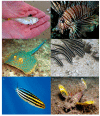Evolutionary Ecology of Fish Venom: Adaptations and Consequences of Evolving a Venom System
- PMID: 30678265
- PMCID: PMC6409815
- DOI: 10.3390/toxins11020060
Evolutionary Ecology of Fish Venom: Adaptations and Consequences of Evolving a Venom System
Abstract
Research on venomous animals has mainly focused on the molecular, biochemical, and pharmacological aspects of venom toxins. However, it is the relatively neglected broader study of evolutionary ecology that is crucial for understanding the biological relevance of venom systems. As fish have convergently evolved venom systems multiple times, it makes them ideal organisms to investigate the evolutionary ecology of venom on a broader scale. This review outlines what is known about how fish venom systems evolved as a result of natural enemy interactions and about the ecological consequences of evolving a venom system. This review will show how research on the evolutionary ecology of venom in fish can aid in understanding the evolutionary ecology of animal venoms more generally. Further, understanding these broad ecological questions can shed more light on the other areas of toxinology, with applications across multiple disciplinary fields.
Keywords: aposematism; coevolution; ecological niche; ecology; evolution; evolutionary ecology; fish; mimicry; natural enemy interactions; venom.
Conflict of interest statement
The authors declare no conflict of interest.
Figures




Similar articles
-
The Diversity of Venom: The Importance of Behavior and Venom System Morphology in Understanding Its Ecology and Evolution.Toxins (Basel). 2019 Nov 14;11(11):666. doi: 10.3390/toxins11110666. Toxins (Basel). 2019. PMID: 31739590 Free PMC article. Review.
-
The evolutionary dynamics of venom toxins made by insects and other animals.Biochem Soc Trans. 2020 Aug 28;48(4):1353-1365. doi: 10.1042/BST20190820. Biochem Soc Trans. 2020. PMID: 32756910 Review.
-
The Evolution of Fangs, Venom, and Mimicry Systems in Blenny Fishes.Curr Biol. 2017 Apr 24;27(8):1184-1191. doi: 10.1016/j.cub.2017.02.067. Epub 2017 Mar 30. Curr Biol. 2017. PMID: 28366739
-
Contextual Constraints: Dynamic Evolution of Snake Venom Phospholipase A2.Toxins (Basel). 2022 Jun 20;14(6):420. doi: 10.3390/toxins14060420. Toxins (Basel). 2022. PMID: 35737081 Free PMC article.
-
Ecological venomics: How genomics, transcriptomics and proteomics can shed new light on the ecology and evolution of venom.J Proteomics. 2016 Mar 1;135:62-72. doi: 10.1016/j.jprot.2015.09.015. Epub 2015 Sep 15. J Proteomics. 2016. PMID: 26385003
Cited by
-
Fine Mapping of QTLs for Alkaline Tolerance in Crucian Carp (Carassius auratus) Using Genome-Wide SNP Markers.Genes (Basel). 2024 Jun 7;15(6):751. doi: 10.3390/genes15060751. Genes (Basel). 2024. PMID: 38927687 Free PMC article.
-
The venoms of the lesser (Echiichthys vipera) and greater (Trachinus draco) weever fish- A review.Toxicon X. 2020 Feb 7;6:100025. doi: 10.1016/j.toxcx.2020.100025. eCollection 2020 Jun. Toxicon X. 2020. PMID: 32550581 Free PMC article. Review.
-
Modern venomics-Current insights, novel methods, and future perspectives in biological and applied animal venom research.Gigascience. 2022 May 18;11:giac048. doi: 10.1093/gigascience/giac048. Gigascience. 2022. PMID: 35640874 Free PMC article.
-
A Chromosome-Level Genome Assembly of the Reef Stonefish (Synanceia verrucosa) Provides Novel Insights into Stonustoxin (sntx) Genes.Mol Biol Evol. 2023 Oct 4;40(10):msad215. doi: 10.1093/molbev/msad215. Mol Biol Evol. 2023. PMID: 37770059 Free PMC article.
-
Integrative multi-omics analysis reveals the contribution of neoVTX genes to venom diversity of Synanceia verrucosa.BMC Genomics. 2024 Dec 18;25(1):1210. doi: 10.1186/s12864-024-11149-6. BMC Genomics. 2024. PMID: 39695923 Free PMC article.
References
-
- Fry B.G., Roelants K., Champagne D.E., Scheib H., Tyndall J.D., King G.F., Nevalainen T.J., Norman J.A., Lewis R.J., Norton R.S. The toxicogenomic multiverse: Convergent recruitment of proteins into animal venoms. Ann. Rev. Genom. Human Genet. 2009;10:483–511. doi: 10.1146/annurev.genom.9.081307.164356. - DOI - PubMed
Publication types
MeSH terms
Substances
LinkOut - more resources
Full Text Sources
Research Materials

